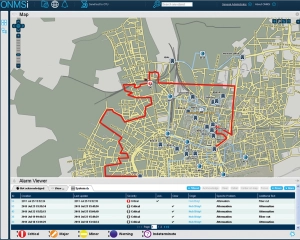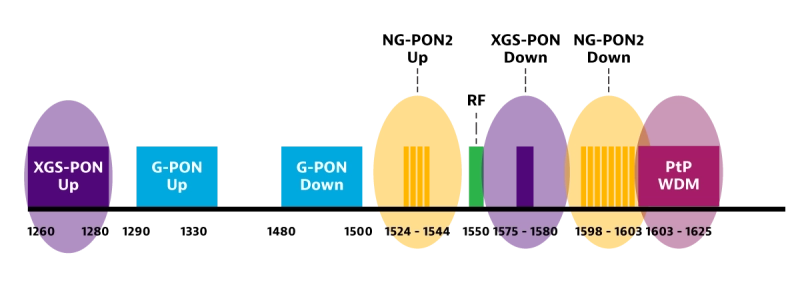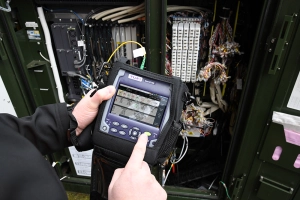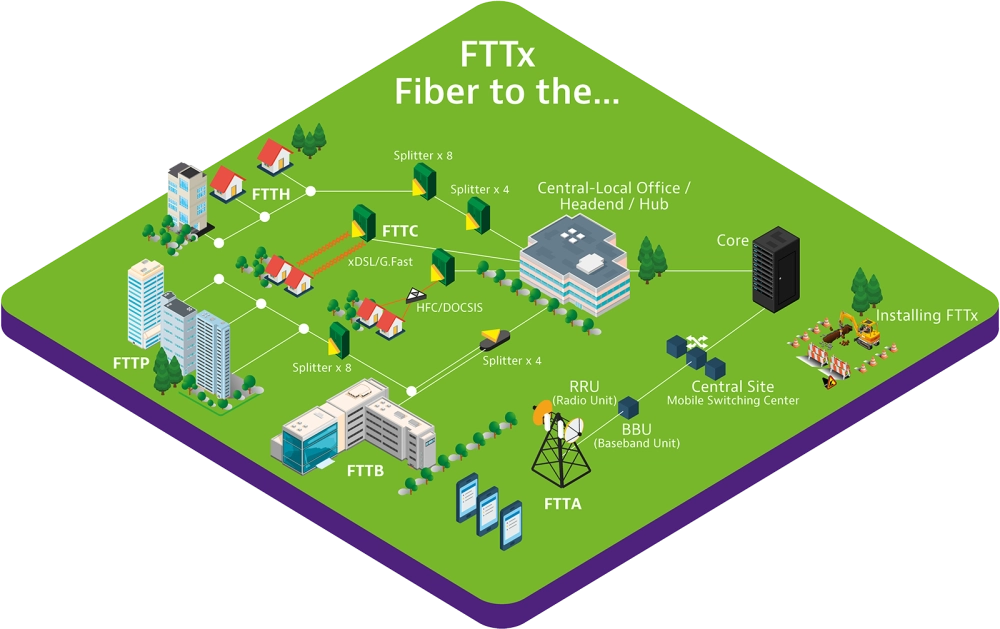What is FTTx?
Learn all about fiber to the "x" including the technology lifecycle and various applications.
Fiber to the “x” (FTTx) is a collective term used to describe a wide range of broadband network architecture options utilizing optical fiber for some or all of their last mile connectivity. With “x” representing the fiber termination point, FTTx technology encompasses optical fiber deployments such as FTTH, FTTA, FTTB, and FTTC.
Jump to Definitions.
Fiber to the x is a central component of next-generation access (NGA), which characterizes the evolution of broadband infrastructure towards enhanced speed and quality of service (QoS).
HDTV, virtual reality (VR) and other bandwidth-hungry applications already push the boundaries of this technology. The IoT, 5G, smart cities and blockchain technology are gaining traction rapidly as the high-speed, low-latency applications for FTTx continue to multiply.
With comprehensive FTTx products including versatile test and monitoring equipment and software, VIAVI has created an optimized tool kit for designing, building and maintaining the quality and reliability of FTTx networks.
FTTx networks bring the combined advantages of higher transmission rates and lower energy consumption. Moving optical fiber closer to the user allows the latest construction, connection and transmission techniques to be leveraged to their fullest extent and diminishes the bottleneck potential of conventional coax. To make this feasible, skillful planning and execution must propagate all lifecycle phases.
Network Design & Planning
The first step towards implementing this technology is well-coordinated design and planning. Prior to establishing the detailed FTTx network design, preliminary planning considerations include the quantity and location of users, fiber distribution and access points, as well as the architectural elements such as passive optical network (PON) technologies that will be included in the design. Detailed design elements at the “micro” level include splice locations, precise distribution patterns and loss budget calculations. Avoiding existing utilities and establishing equipment locations are some of the other considerations included in a comprehensive FTTx network design.
Deployment
Meticulous network planning is an essential requirement for a successful FTTx deployment. Timelines for cable splicing and splitter installation can be aggressive, so attention to detail, accurate labelling, efficient routing and prudent test practices are necessary to avoid delays.

Although most components are factory-tested, the verification of splices and terminations in the field remains one of the most important elements of FTTx deployment. Incorrect splicing, contaminated connectors or microbends can lead to optical loss and decreased QoS. A construction certification plan implemented with Test Process Automation can help to mitigate these risks.
Customer Connections and Installations
Service providers and contractors are under significant pressure to deploy fiber quickly and cost-effectively, while ensuring high quality, reliable installations. No test or limited test often looks like a good way to reduce deployment cost and time, however, it is proven that a lack of testing leads to activation delay, excessive troubleshooting, and loss of revenue. Proper testing during construction and installation phases is the only way to certify a FTTx link and provide a record of compliance to ensure successful first-time turn-up and reduce unnecessary truck rolls or repeats.
Monitoring & Maintenance
Ensuring performance once a successful deployment has been completed can only be accomplished through ongoing monitoring and maintenance. A single fiber link might connect an enterprise to thousands of customers and carry with it valuable and sensitive data.

Solutions like the VIAVI Optical Network Management System (ONMSi) can remotely detect and locate fiber degradation or faults quickly and accurately. Monitoring and measurement of FTTx networks can also improve security and performance by quickly detecting intrusions and establishing long-term fiber quality trending practices.
Downstream Wavelength of FTTx
For most FTTx applications, voice and data transmission from the OLT are produced at a downstream wavelength of 1490 nm. Wavelength division multiplexing (WDM) enables an upstream connection wavelength at 1310 nm so that bidirectional transmission can occur over the same fiber. Inexpensive laser optic technology can be utilized at the ONT (user) end. Newer and faster iterations of PON technology, such as NG-PON2 and XGS-PON, operate at slightly different downstream and upstream wavelengths. This allows multiple PON architecture types to be used simultaneously or interchangeably, depending on the service level requirements.

FTTx vs FTTH
While the acronyms are often used interchangeably, they are actually quite different. While the “x” factor of FTTx can be substituted for any termination point at or close to the subscriber or customer, FTTH has a more specific definition. Fiber to the home eliminates any residual coaxial or copper cable between service providers and the customer, creating a purely fiber optic connection to their home. Essentially, FTTH is a very important subset of FTTx.
The distinction and meaning of the word “home” in FTTH is also an important differentiator. This term is used to distinguish the direct fiber connection to a living space from other direct connections made to schools, businesses or individual offices. The quality and configuration of FTTx applications can be customized to suit the needs and expectations of the customers.
The various options encompassed under the FTTx umbrella each bring advantages and features that make them suitable for specific applications and less appropriate for others. The list of potential configurations is extensive with some becoming increasingly common FTTx architectural solutions.
FTTH
Fiber to the home (FTTH) creates a direct fiber connection to the resident’s junction box, thereby offering the highest possible bandwidth option to individual home subscribers. Since this option can also be expensive to install, it has been more prevalent in areas of new construction. One potential drawback of FTTH is power line placement. Because electrical power cannot be delivered over fiber optic cables, these deployments might require entirely separate power lines to be installed. Despite these challenges, FTTH has become one of the most popular applications worldwide.

FTTA
Fiber to the antenna (FTTA) is a network architecture utilizing fiber optics to distribute the signals from a baseband unit (BBU) to a remote radio head (RRH) near the top of a cell tower. FTTA technology is an essential element of 5G, since massive MIMO translates to more antennas and more cabling. The lower weight and reduced wind resistance makes it a logical replacement for coax cabling in this application. FTTA also allows more flexible placement of the baseband unit, since the fiber optic link to the RRH can potentially span long distances.
FTTB & FTTP
Fiber to the building (FTTB) is similar to FTTH, except the fiber termination is completed somewhere other than a private home. The “B” can also stand for business or basement. A basement termination would typically be found in a multi-tenant dwelling where fiber would feed into a designated electrical room. Fiber to the premises (FTTP) is a blanket designation including FTTH and FTTB. The commonality between all FTTP configurations is fiber travel beyond the property boundary, whether that property is a home, apartment building, small business, or school.
FTTN
Fiber to the node (FTTN) incorporates fiber optic links that terminate at a central node proximal to the businesses or homes of the end users. From the node location, the connection is completed through existing coaxial or copper cable infrastructure. A typical FTTN configuration might serve several hundred customers from a single node position. The node is usually a mile away or less from all customer locations because a longer coax segment can more significantly impact speed.
FTTC
Fiber to the curb (FTTC) is a somewhat misleading acronym since the term “curb” is used to describe an enclosure or pole where the network hardware is installed. Fiber to the curb is similar to FTTN, but fewer customers are served from each location and the coax distances are usually much shorter. This configuration is a useful one since it comes close to providing a direct fiber link yet does not require a fiber connection within the property boundary.
FTTx Products
See our FTTx solutions for a list of products.
The Future of FTTx
Increased cloud adoption, smart cities and the arrival of 5G are just a few of the obvious reasons why low-latency, high-bandwidth fiber networks have become the media of choice for both operators and consumers. FTTx provides the infrastructure through which all current communication modes can achieve ample capacity and consistent connectivity. Extending the reach of a fiber network provides the additional benefits of long-distance signal transmission, lightweight form factor and immunity to electromagnetic interference.
It is not surprising that FTTx network deployment is expected to accelerate continually over the next decade. With the “x” creating unbounded flexibility, there is no limit to potential FTTx options in the future. VIAVI will continue to provide the diverse equipment and technology that has made these possibilities a reality.
Partner with VIAVI on your FTTx needs today!
Are you ready to take the next step with one of our FTTx products or solutions? Complete one of the following forms to get going:
